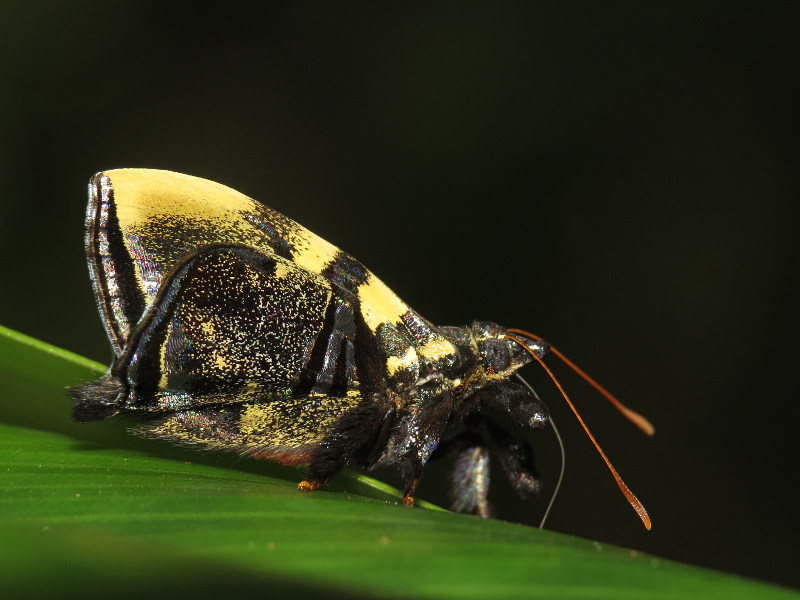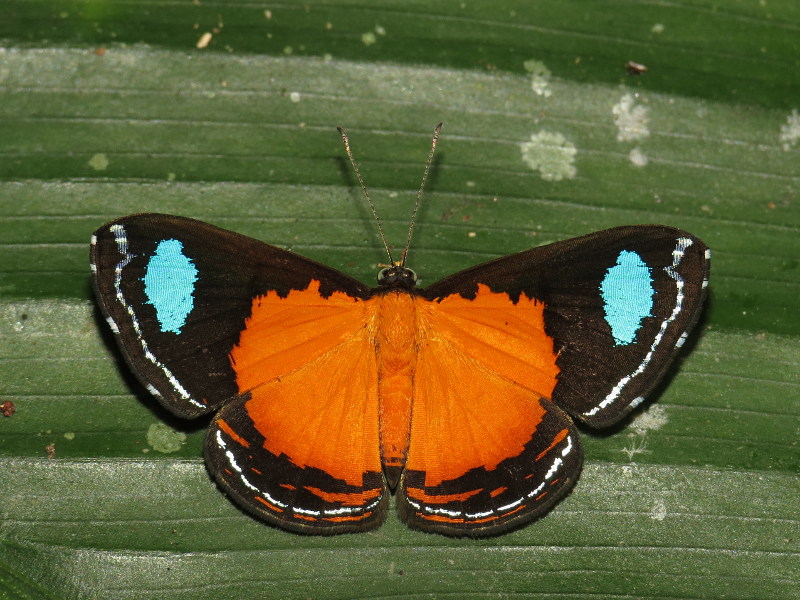I post almost all of my butterfly photographs on flickr, and for a full selection of pictures from a certain tour or site, you can browse my albums here. I present here just a few of my very favourite photographs representing a range of species and sites. Enjoy!
Mariposa Butterfly Tours Gallery

Arcas imperialis
Yulitunqui Area, Peru
I'll start with a South American classic! Whenever we find one, this is always one of the most popular butterflies of the tour. Luckily it is widespread and not especially rare, though you need one to settle on bait for a decent chance of a good picture. This particular individual hung around for at least an hour and everyone in the group got great shots; a year later, in the same area, I saw one for exactly 20 seconds - just long enough for two people to shoot before it was gone!

Carystus jolus
Mishquiyacu, Peru
Grass skippers are generally much less popular - but look at these two beauties! The Carystus is a lowland/foothill forest butterfly, while the Thespieus inhabits high Andean habitats.
Thespieus fassli
Paucartambo, Peru


Entheus aureolus
Surama, Guyana
And while I'm showing off skippers, here are a few beautiful spreadwings! This is the only Aurina dida I've ever seen, and I was shocked by how TINY it was - I thought I was watching a small moth or metalmark bombing around until it finally landed!
Aurina dida
Iwokrama, Guyana

Phareas coeleste
Manu Road, Peru
And this would get most people's vote for the most spectacular Neotropical skipper (perhaps along with some gaudy firetips!). The two previous shots were both under leaves, which makes for very challenging photography, but this Phareas is on a spitwad! For the uninitiated, that's a little bit of tissue paper that's been chewed on and offered as bait. Some purists don't like the technique, citing spoiled photographs - but I'll gladly take a few shots with ugly white blobs in them as payment for this stunner!

If you go butterflying above about 1500 m. in the Andes, especially on the E slope, a large portion of what you see will be Catasticta dartwhites, Dalla skipperlings, and satyrs, satyrs, satyrs. Although often maligned as dull and/or unexciting, I simply have to disagree - there are some beautiful, unique, and especially lots of rarely-seen species to be found! These three species are examples of what you might expect from each group:

Catasticta prioneris
PN Tatama, Colombia

Dalla jelskyi
Pampa Hermosa, Peru

Daedalma dinias
Cabañas San Isidro, Ecuador

Mesosemia eumene
Morro de Calzada, Peru
Okay, I've held off long enough - my favourite butterflies are the metalmarks! There is so much variety in the Noetropics in terms of colour patterns, shapes, and behaviour. Mesosemia is a huge and widespread genus that includes some spectacular butterflies, like this one, but also has plenty of little brown guys that are very difficult to identify. Like the afore-mentioned spreadwing skippers, this guy was sitting under a leaf, as many metalmarks do, and I was thankful once again for my camera's articulating screen!

Sarota acantus
Rio Claro, Colombia
Allow me two more metalmarks! More to come later, of course. Jewelmarks like this Sarota are especially popular, and challenging - remember, these guys really are tiny!
Nymphidium mantus
Iwokrama, Guyana

Antirrhea undulata
PN Tatama, Colombia
Okay, time for a few crowd-pleasers. Most of my favourite butterflies are small, for some reason, but a lot of the people on my trip like the big ones - like this guy! I found it on a drizzly day when I probably shouldn't have been butterflying at all... or so I thought until getting this picture! Like most morpho-types, it's very rare to get a chance for an open-winged shot of Antirrhea, so I was thrilled when this one slowly opened up and basked for several minutes.


Neographium leucaspis
Manu Road, Peru
If there were a crowd pleaser family, it would have to be the swallowtails and there's no denying their beauty. These two wonderful butterflies were photographed on the same bridge, although on dates about a year apart!
Pterourus bachus
Manu Road, Peru

Time for some of my favourite hairstreaks! These are three beauties from three difference countries; no matter where you go in the Neotropics, there will be great hairstreaks around. The challenge with them often is that most species seem to spend their time in the canopy, out of photography range. But once in a while, one comes down to bait or simply perches within reach - and takes your breath away!

Paiwarria telemus
PN Yanachaga-Chemillen, Peru

Calycopis sullivani
PN Tatama, Colombia

Evenus satyroides
Tena, Ecuador

Haemactis sanguanalis
Manu Road, Peru
I actually really like skippers of all kinds, and there are a few that are guaranteed to get most people excited - like this "lipstick skipper!" The high-elevation Metardaris is also popular.
Metardaris cosinga
Abra Malaga, Peru


Ourocnemis archytas
Manu Road, Peru
Simply put, this is one of my favourite all-time butterflies. It had already been a wonderful day at Villa Carmen, with amazing skippers, hairstreaks, and metalmarks of all colours and shapes. Late in the afternoon, Karen and John reported having seen a strange metalmark, and John said "Just look for the weevil." I wasn't sure why... but when I got there, and saw this weevil-butterfly cross, I got it. This kind of surprise is what makes Neotropical butterflying my favourite activity in the world!

Polygonia faunus
Kinbasket Lake, Canada
Allow me two North American shots in here - I do this stuff at home too! I actually really enjoy butterflying my home continent, especially in the western half of it, where I found these two beauties.
Colias meadii
Guanella Pass, U.S.A.

Chloreuptychia tolumnia
Iwokrama Reserve, Guyana
Back to the tropics - we've got satyrs in North America, but nothing like this! Although many Chloreuptychia are shimmering blue all over and everyone loves them, and so do I, but this is probably my favourite in the genus with those soft purple tones mixed in with the brilliant blue highlights.

I mentioned previously that I love the variety within the metalmark family - so here are some examples! They're not all colourful (though some are - look at the Symmachia in the middle!); in fact the Styx is about as dull as a butterfly can be. But it is endemic to the Peruvian cloud forests, flutters around like it's about to expire, sits in strange places, and has a great name! The Eunogyra spends most of the day sitting inconspicuously under leaves in the Amazon understory, but at dusk the males sit in the open and emit pheromones (at least that's what I assume the one in this photograph is doing!).

Styx infernalis
Bosque Shollet, Peru

Symmachia titiana
PN Tatama, Colombia

Eunogyra satyrus
Manu Road, Peru

Prepona claudina
PN Yanachaga-Chemillen
With all the ranting and raving about metalmarks, skippers, and hairstreaks, you might think I tend to ignore brushfoots - not true! Here are two nice ones as evidence that I look at them too!
Cybdelis phaesyla
Playa Mariposa, Peru


Yanguna spatiosa & Yanguna cometes
Pampa Hermosa, Peru
Okay, time for more ranting and raving about skippers! Firetips are among the most popular skippers, for obvious reasons, and Yanguna are among the most spectacular of firetips. For whatever reason, Central Peru seems to be a hotbed so these big gaudy skippers, but finding two species lined up nicely like this is still pretty unusual!
I'm going to include a final trifecta of mind-blowing metalmarks. No special theme here - they're just three of my favourite spectacular bugs!

Argyrogrammana bonita
Apuya Track, Ecuador

Euselasia euodias
Manu Road, Peru

Symmachia accusatrix
PN Yanachaga-Chemillen, Peru
Talides montezuma
PN Tatama, Colombia
Okay, I love skippers - even the dull ones - but why put this one in my gallery? Well, this is the one species that I really can claim to my name, and this butterfly - the individual in this picture - is the type specimen! By the time I took this photograph, I knew it was an undescribed species based on previous photos I'd sent to experts. So I collected this guy after taking the picture, and it ended up in the collection of Julian Salazar and this article (it looks a bit less flattering there...). Anyway, excuse my narcissism, but this is one my pet bugs!

So how unusual is it to encounter a new species of butterfly? In South America it's not that unusual, actually. Over the years I've encountered at least a dozen of them, most of which are already known to professional lepidopterists. Here are three examples; the two from Pampa Hermosa are dusky-flying skippers that I believe have not been collected, but the clearwing has been, and will eventually be described.

Eudaminae sp.
Pampa Hermosa, Peru

Venada sp.
Pampa Hermosa, Peru

Haenschia sp.
Manu Road, Peru

Enos polka
Manu Road, Peru
And to finish off, one more wonderful hairstreak. Like a lot of the photographs in this gallery labelled "Manu Road," this one was shot at Quebrada Quitacalzon - one of the best spots on one of the best butterflying roads in the world!






